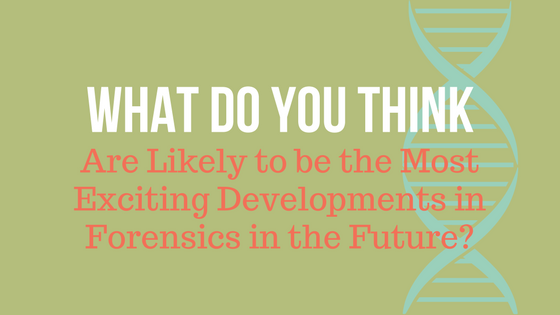Forensic Science has come a long way since the discovery of PCR in 1983. From DNA fingerprinting to silver staining to multiplex kits, the industry is constantly evolving. But what’s next? We asked our ISHI 28 speakers what they think are likely to be the most exciting developments in the field of forensics over the next couple of years. Do you agree? Join the conversation on our Facebook and Twitter pages!
“Of course I am biased on what I am working on. But I think massively parallel sequencing is one. Another is the potential for the human microbiome to serve as another way to identify humans (which may improve LCN samples as well).”
 Chantal Frégeau, Royal Canadian Mounted Police
Chantal Frégeau, Royal Canadian Mounted Police
“I would have to say:
The rapid and highly specific tests for the simultaneous detection of body fluids based on mRNA markers which will enhance the work currently performed in Evidence Recovery
Massively parallel sequencing (MPS)-related products such as new kits, new interpretation tools, harmonized nomenclature for sequenced STRs (nominal alleles and sequence variants) and probabilistic software for MPS data.”
 Scott Kennedy, University of Washington
Scott Kennedy, University of Washington
“The introduction of MPS is likely the most important development in human identification.”
 Sylvain Hubac, Forensic Science Laboratory of the French Gendarmerie (IRCGN)
Sylvain Hubac, Forensic Science Laboratory of the French Gendarmerie (IRCGN)
“I think so because there is a real need not only for DNA, but also for other forensics applications (fingerprint, digital, …..). We can imagine modular structures that you can assemble together, each module being dedicated to a specific forensic application. According to this modular concept, you can provide quickly and keys in hand a customized forensic lab depending the real need and goals of the country.”
 Cristina Rentas, DNA Labs International
Cristina Rentas, DNA Labs International
“I think that the next few years will be very exciting for the forensic science community. As more and more states are beginning to use familial searching for their casework, I expect to see fewer crimes going unsolved because of the leads that this technique is able to provide.
In addition to this, since eliminating the sexual assault kit backlog has become a major topic of discussion in the industry, I believe it’s very likely that we will see the option for probabilistic genotyping software for Y-STRs. We have already seen cases at our laboratory where this software would be helpful so I think it’s a matter of time before that becomes available to the community.”
 Mike Yakoo, Program in Biomedical Forensic Sciences, Boston University School of Medicine
Mike Yakoo, Program in Biomedical Forensic Sciences, Boston University School of Medicine
“While I’m not one to speculate on these sorts of things, I think forensic DNA analysis might be making a shift towards next generation sequencing. Additionally, the collaborations that are happening between experts and researchers in various disciplines, I think, have the potential to make significant contributions to forensic DNA analysis.”
 Mandy Fashano, Columbus Police Forensic Services Center
Mandy Fashano, Columbus Police Forensic Services Center
“I am really excited about rapid DNA processing type extractions (i.e. Promega’s Casework Direct Kit) and technology (i.e. Rapid DNA). I think the DNA industry has done a great job at releasing new and improved quantification and amplification kits, and new CE technology that makes downstream processing faster than ever before. Male DNA screening has also increased the sexual assault kit turn-around times significantly. Yet, DNA extraction methods have still been lagging behind on catching up to the rest of the technology in decreasing processing time, reagents, consumables, and transfer steps.”
 Rachel Oefelein, DNA Labs International
Rachel Oefelein, DNA Labs International
“Capillary electrophoresis (CE) and short tandem repeats (STR) analysis has been the go to for the industry for years now. I don’t envision STR analysis disappearing any time soon but I do think we are going to see significant advancement in other methodologies available; from CE instruments available to laboratories to new DNA targets, like Single Nucleotide Polymorphisms (SNP) and Retrotransposable Insertion Polymorphisms (RIP), to massively parallel sequencing… the list of what’s coming just around the corner is long! I’m excited to see which technologies take hold among the industry.”
 Paul Berry, Louisiana State Police
Paul Berry, Louisiana State Police
“Probabilistic Genotyping has for some time been seen as this black box where magical computations happened which produced results that seemed impossible to defend in court. Now that people are becoming more educated about PG, the mystery is being replaced by understanding. I know at our lab hours are often spent deliberating the best way to interpret a mixture, and disagreements often lead to frustrations. With PG I think the time spent debating interpretations can be better spent in other ways: making the lab more efficient, tackling backlogs, or validating new procedures. Many times we have had to say the profile was “inconclusive for the suspect” based on our interpretation guidelines, but often our analysts could SEE that the profile suggested the suspect was in fact present, but the rules prohibited an inclusion. Probabilistic genotyping seems to be the next great step in solving crimes and resolving discrepancies.”
“I think the advancement of microbial forensics applications (i.e., human identification, post-mortem interval, geolocation, phenotypic/lifestyle, infection source tracking) and molecular autopsy will provide some of the most exciting developments for the forensic field. Advancements in molecular methods, especially massively parallel sequencing, allow us to gather more data than ever before to provide more evidence to help produce investigative leads.”
 Michael Marciano, Forensic and National Security Services Institute, Syracuse University
Michael Marciano, Forensic and National Security Services Institute, Syracuse University
“The move to DNA sequence analysis is exciting. Enhancing the ability to interpret DNA mixtures allows for the interpretation of samples that may have been too complex for fragment analyses. This also will give birth to a new world of software and predicative tools that will permit new methods of genetic identification.”
WOULD YOU LIKE TO SEE MORE ARTICLES LIKE THIS? SUBSCRIBE TO THE ISHI BLOG BELOW!
SUBSCRIBE NOW!




